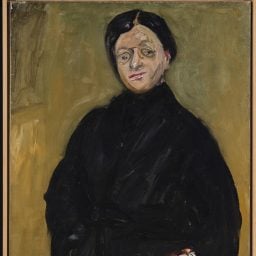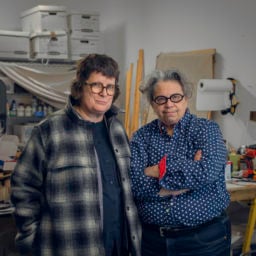Over her 50-year career, the American artist Lenore Tawney created intricate, abstract fiber artworks that took on sculptural and even spiritual dimensions. Her works were an unprecedented vision of what textile art could be in New York’s mid-century art scene. Working for a time at the famed Coenties Slip in Lower Manhattan, Tawney worked amid a distinct downtown milieu that included Ellsworth Kelly, Robert Indiana, Jasper Johns, and Agnes Martin, the latter of whom was her close friend and confidant. A generation of fiber artists below her, including Sheila Pepe and Ferne Jakobs, have found inspiration in her works.
But in the wider art world, Tawney has remained an obscure figure, an outlier in the narrative of modern art. Recently, however, Tawney is on the precipice of long-overdue recognition.
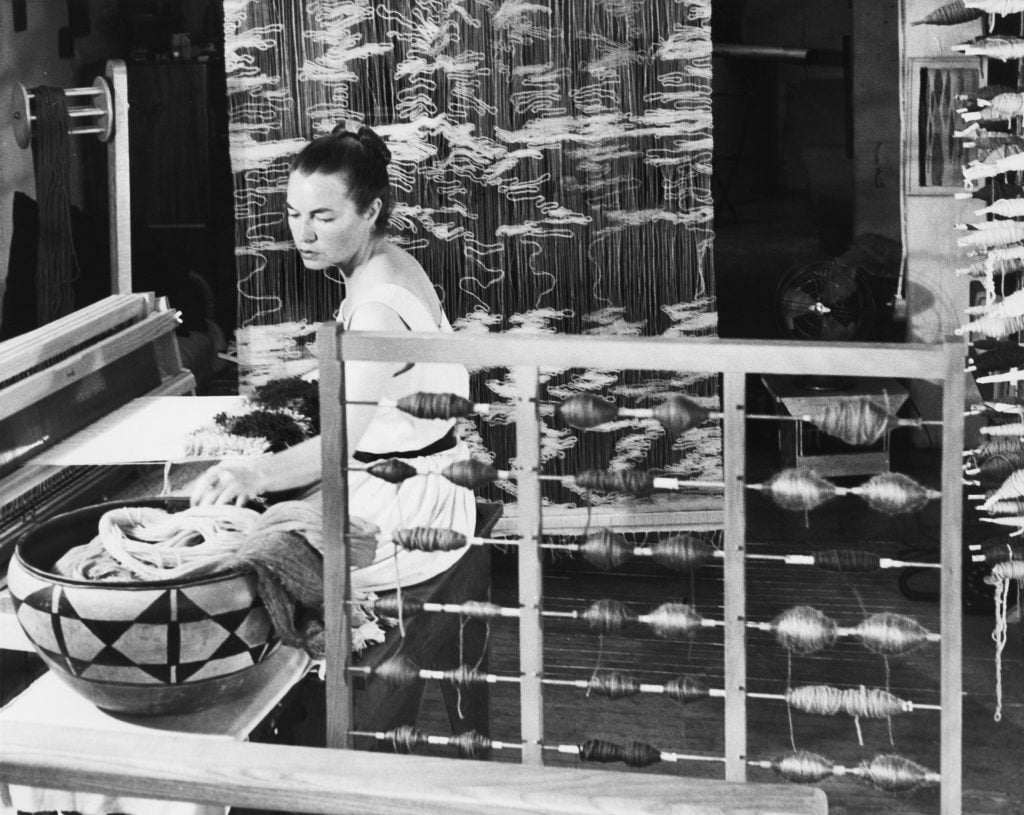
Fiber artist Lenore Tawney poses for a portrait in her studio at 27 Coenties Slip in 1958 in New York City, New York. (Photo by David Attie/Getty Images)
This week, London gallery Alison Jacques is presenting “Time Trembling” a solo booth of Tawney’s works at the Independent 20th Century art fair in New York (on view from September 5 through 8). While Tawney is certainly best known for her woven works, this presentation also foregrounds other important bodies of work including drawings, collages, and assemblage sculptures, while emphasizing her influences in Taoist thought, Indigenous American textile traditions, and Bauhaus philosophy.
The installation at Independent builds off the recent momentum, notably her work’s inclusion in “Weaving Abstraction in Ancient and Modern Art” at the Metropolitan Museum of Art in New York as well as in “Toshiko Takaezu: Worlds Within” at the Noguchi Museum in New York and “Takaezu & Tawney: An Artist is a Poet” Crystal Bridges Museum of American Art, Arkansas, all earlier this year. This November, Alison Jacques will devote a solo exhibition to her work at their London gallery.
The presentation on view at the fair offers a glimpse of an utterly captivating artist with an oeuvre just now coming into focus. “We have devoted part of the fair each edition to an artist who has lived and worked on ‘the slip,” said Elizabeth Dee, the founder of Independent Art Fair. “It’s particularly meaningful to see Tawney featured this year… She forged a reassessment of abstraction’s potential beyond expressionism, using line to pioneer conversations around sculpture and installation art before the (mostly male) American minimalists delivered their treatises on the activations of space.”
Unlikely Artistic Origins
So who was Lenore Tawney and what is her legacy? Tawney was, in many ways, an exception. She was nearly 40 years old when she committed herself to making art. Her career only truly blossomed in her 50s and 60s.
Born Lenora Gallagher in Lorain, Ohio, she moved to Chicago at the age of 20, finding work as a proofreader for a publisher. Tawney’s first forays into art were through night classes at the Art Institute of Chicago. In 1941, she married the psychologist George Tawney, whom she’d met through friends, but their marriage would be tragically cut short by his death from pneumonia less than two years later.
After her husband’s death, Tawney turned more fully toward art, enrolling in Chicago’s Institute of Design in the fall of 1946. The school was home to many exiled European artists, particularly from the Bauhaus. There she took classes with László Moholy-Nagy, Alexander Archipenko, and Marli Ehrman, with whom she studied weaving. During these years she traveled broadly, visiting Mexico, Europe, North Africa, and the Middle East, and exploring non-Western spiritual traditions.
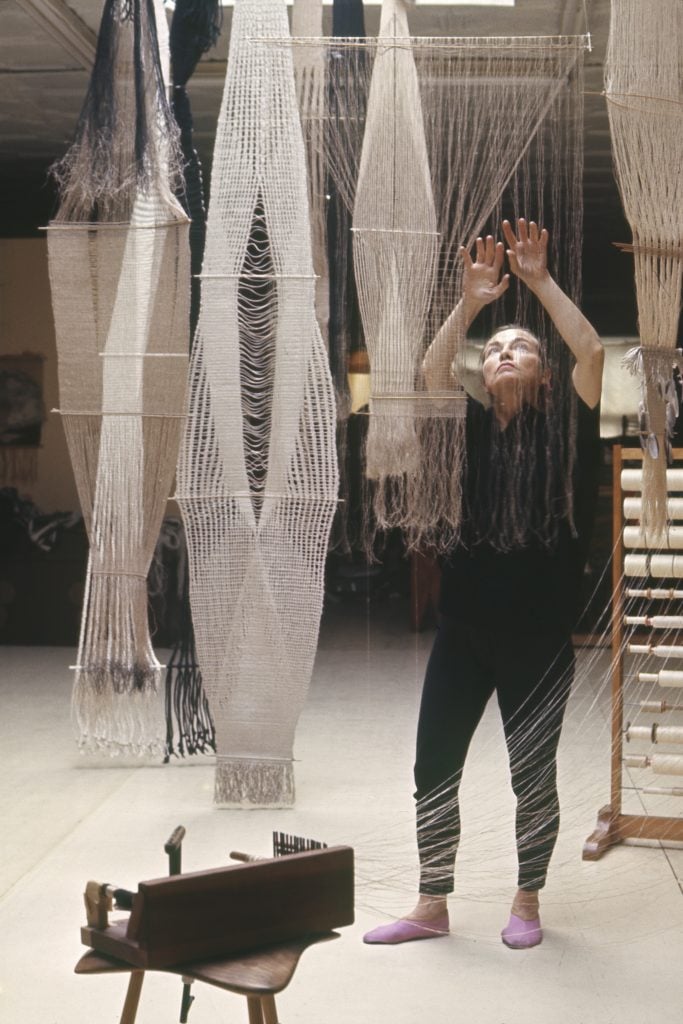
Lenore Tawney in her studio at 59 Beekman Street, New York, 1966. Photo: Nina Leen. Courtesy Lenore G. Tawney Foundation
During her career, Tawney had acute moments of revelation as she quested to evolve her artistic voice. Famously, after having spent a summer making sculptures at Archipenko’s studio in Woodstock, New York, Tawney abruptly smashed her work by throwing it into the cellar (three works from that series survived). Though Tawney ultimately turned away from sculpture, her later weavings would continue to be formed by sculptural principles.
Though Tawney had begun weaving in the late 1940s, in 1954, she experienced a breakthrough after taking a modern tapestry class taught by Finnish weaver Martta Taipale at the Penland School of Crafts in North Carolina. Early works from this era include her first representational weaving, St. Francis and the Birds (1954). As Tawney developed dexterity with her chosen medium, her works quickly began to adapt in increasingly experimental ways. By the mid-1950s, she had embraced “open-warp weaving,” which leaves a portion of vertical threads unsupported, creating freer, more evocative, and ephemeral weavings.
Studio as Sanctuary

Lenore Tawney, Untitled (1961). Photography by Michael Brzezinski © Lenore G. Tawney Foundation. Courtesy The Lenore G. Tawney Foundation, New York, and Alison Jacques, London.
In 1957, Lenore Tawney’s real life as an artist began when she left behind the security of her life in Chicago for then unknown possibilities of life in New York City. There she rented a loft studio space in Coenties Slip near the South Street Seaport—just steps where her works will be displayed at Independent. Tawney arrived with bare necessities: a refrigerator, her loom, and her cat, with plans to stay for a year. In the end, she never left New York.
“I left Chicago to seek a barer life, closer to reality, without all the things that clutter and fill our lives,” she said, “The truest thing in my life was my work. I wanted my life to be as true. I almost gave up my life for my work, seeking a life of the spirit.”
At 27 Coenties Slip, in a quiet neighborhood overlooking the water, she found herself amid an informal community of artists including Jack Youngerman and his wife, the filmmaker Delphine Seyrig, as well as Ellsworth Kelly, Robert Indiana, James Rosenquist, and Agnes Martin. Robert Rauschenberg and Jasper Johns lived and worked a few minutes away. This group of artists lived and worked conscientiously apart from the raucous Greenwich Village scene of the Abstract Expressionists.
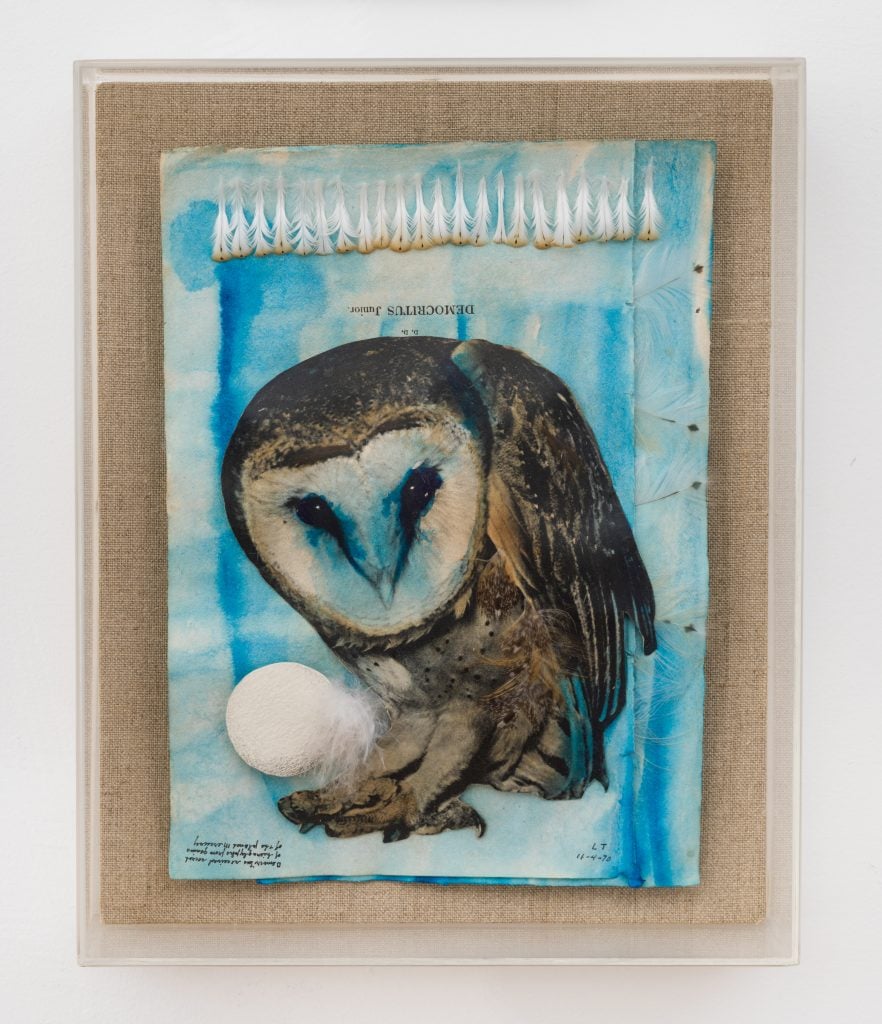
Lenore Tawney, Democritus Junior. (1970). Courtesy of Alison Jacques.
But even in this more subdued milieu, Tawney was a woman apart. When Hans Namuth came to shoot the artists of the Slip for a 1958 edition of Life magazine, she was conspicuously absent. Still, Tawney seemed to embrace her solitude, as her works continued to develop and shift through the 1950s and 1960s. Tawney would ultimately leave her Slip studio for another Seaport space, a former sailmaker’s studio. These studios, and the many studios Tawney would work in across downtown Manhattan over the decades, became an extension of her practice, hallowed sanctuaries where she worked with cloistered focus. Often, her surrounding environments influenced her works materially, with Tawney adding feathers and twigs to her creations, or, given the height of her studio ceilings, allowing her to build her works to monumental scales.
Around the early 1960s, she incorporated an “open reed” into her weaving process. The reed is a comb-like tool that separates threads while weaving, and the open reed allowed Tawney to adjust her warp threads at various points in her process, meaning she could adapt the works’ geometric forms at any point. Another pivotal moment came in 1961, when Tawney took lessons with German artist Lili Blumenau, focusing on Peruvian textile traditions, exposure that encouraged Tawney toward a limited color palette and smooth linen threads. Tawney did find institutional success with many of these works and had exhibitions with the Staten Island Museum in 1961, a solo show at the Art Institute of Chicago in 1962, and a floor devoted to her work in “Woven Forms” a group show at the Museum of Contemporary Crafts in New York in 1963.
Her showstopping 1962 weaving Dark River was even acquired by the Museum of Modern Art in New York, though towering at a rapturous 14 feet, the work has yet to be shown by the museum.
The Wider Net of Expressions
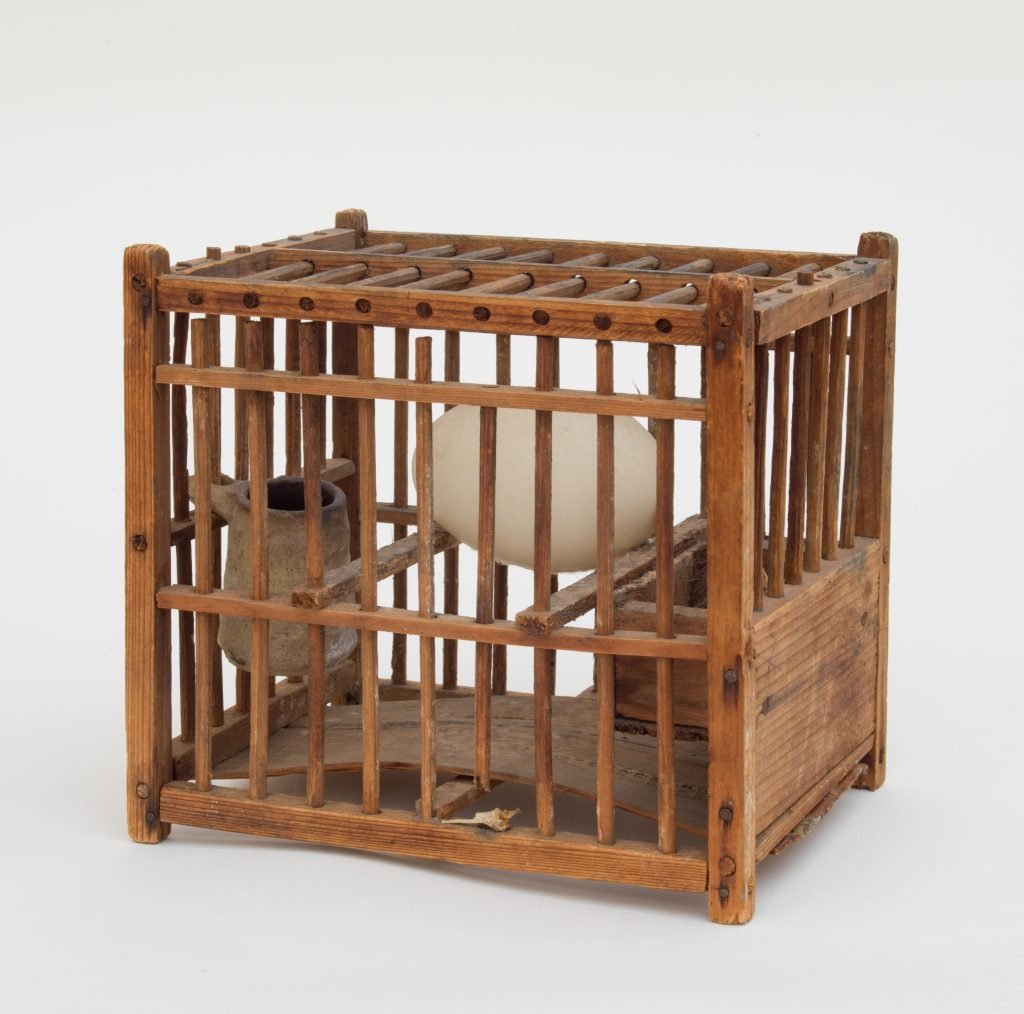
Lenore Tawney, Time Trembling (1969). Courtesy of Alison Jacques.
Tawney’s weavings have always been at the center of conversations about her practice, but the presentation at Independent adds complexity to those narratives, highlighting the diversity of her work and materials. Tawney, much like Joseph Cornell, was a collector of ephemera and objects culled from her surroundings. Many of these objects found homes in Tawney’s assemblages and collages, cipher-like riddles of feathers, stones, and bones. In their imagery and their titles, these mixed-media works often reference the classical or ancient world. Often shrine-like, these works are in dialogue with contemporaneous assemblage artists and Rauschenberg’s combines but also feel like offerings or amulets rooted in Tawney’s spiritual journey.
On view at the fair, the mixed-media work Democritus Junior depicts an owl painted on an old book page, with white feathers affixed to it—the name Democritus Junior is printed on the page, an allusion to an ancient and famously melancholic philosopher. Alison Jacques’s presentation, meanwhile, takes its name from the work Time Trembling (1969) a wooden cage holding a clay pot and an egg, a form suggesting incubation, hidden life waiting to spring forth in time.
In some ways, Tawney is reminiscent of Penelope in The Odyssey, working and unworking at her loom, leaving obscured passages, biding her time for a moment when her ideas might better be understood.
Independent 20th Century takes place September 6–8, 2024, with a VIP Day on Thursday, September 5, 2024, at Casa Cipriani 10 South Street New York, NY 10004.








